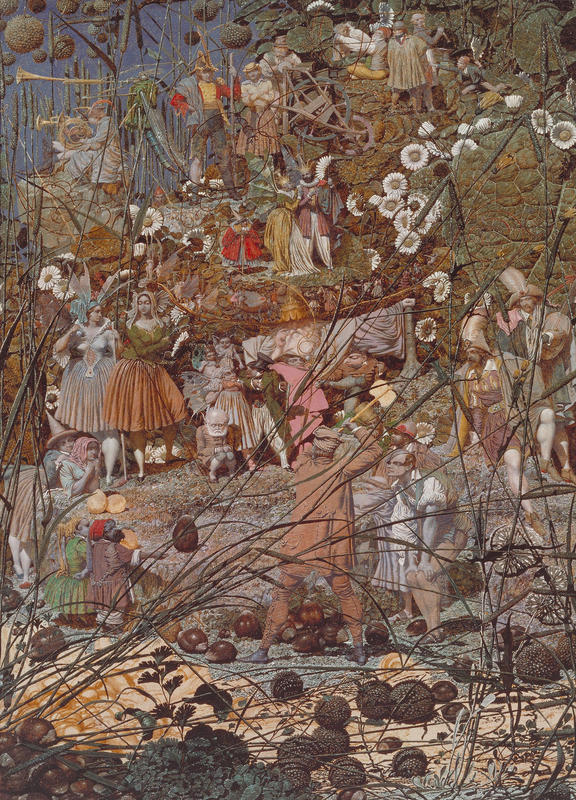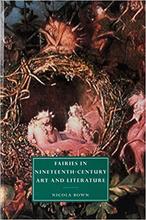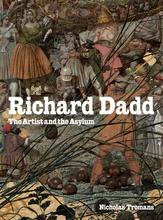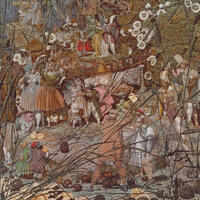More about The Fairy Feller's Master-Stroke
- All
- Info
- Shop

Sr. Contributor
Richard Dadd persevered with painting the extensive details of The Fairy Feller’s Master-Stroke for nine years. You can only really grasp the detail if you see it in person.
In fact, even then, it is difficult to see all of the nuances in this work. To call Dadd detail-oriented would be an understatement. In completing this piece, he would work on one tiny section at a time. He would draw a detailed sketch, then paint that small section. He would go over and over the area, layering on thick masses of paint. It’s practically a sculpture instead of a painting because of how three-dimensional the paint became. This alters the perspective of the piece, adding to the magical quality of the fairyland.
And yes, it is magical, but it is also haunting. For one thing, it depicts a patriarch wearing a triple crown, which seems to be a reference to the Pope. It also includes an apothecary that is a portrait of the artist’s biological father. Neither of these characters seems particular sinister … unless you happen to know that Richard Dadd lived most of his life in a psychiatric asylum after he threatened to kill the Pope and actually did kill his own father.
You would think that Dadd put enough detail into this piece to have finally completed it after nine years. However, he didn’t seem to think that people would get it, because he later wrote a poem about it, trying to explain in words what the imagery is all about. It’s a long poem that reads like what it is - the ramblings of someone with lifelong schizophrenic delusions. There are hundreds of characters in the painting; the poem tells us all about each of them. And yet, at the same time that he explains the work, he denies that it has any inherent meaning.
Nevertheless, people “got it” or at least they were inspired by it. Most famously, Freddie Mercury of Queen wrote a song about it. Some of the lyrics come straight from Dadd’s poem. Octavio Paz and Neil Gaiman are two well-known writers who have cited the work’s influence. But perhaps the most interesting work that describes this painting is a book by Lesley Krueger called “Mad Richard,” which is a strange work of historical fiction in which Charlotte Bronte’s life is intertwined with Dadd’s. In this story, Charles Dickens' father also visits Dadd and calls him out about the painting. The fairy feller is painted before having struck his ax, and Dickens asks if it’s a sign that Dadd wishes things were unstruck, which leaves the fictional Dadd confused.
Sources
- Tate. “Richard Dadd: The Fairy Feller’s Master Stroke.” Accessed October 5, 2018. https://www.tate.org.uk/art/artworks/dadd-the-fairy-fellers-master-stro…
- Davidson, Jonathan. “Images in Psychiatry. Richard Dadd and the Fairy Feller’s Master Stroke.” Am J. Psychiatry 172:11 November 2015. Accessed October 5, 2018 https://ajp.psychiatryonline.org/doi/pdf/10.1176/appi.ajp.2015.15070913
- Irving, Carolina et.al. “Bohemian Rhapsody.” New York Times. February 10, 2015. Accessed October 5, 2018 https://www.nytimes.com/2015/02/10/t-magazine/in-the-air-bohemian-rhaps…
- Byatt, AS. “Richard Dadd: the fairy king.” The Guardian. Accessed October 5, 2018 https://www.theguardian.com/artanddesign/2011/sep/02/richard-dadd-fairy…
- Gaiman, Neil. “The Fairy Feller’s Master Stroke.” Accessed October 5, 2018 http://journal.neilgaiman.com/2008/04/fairy-fellers-master-stroke.html

Contributor
The Bethlem Hospital for the criminally insane commissioned this fairy painting from inmate Richard Dadd.
It's considered his masterpiece and we can see why. The OCD at work here is spectacular. Never has so much minute detail been worked into a single canvas. And after 6-9 years of work, it is still unfinished!
Fairies were a big thing in mid-1800s UK. Unlike today, they were creepy and feared and avoided. Fairies were not just pranksters, but kidnapped people and could spread the deadly disease tuberculosis. They caused unknown illness in cattle and other farm animals. To protect youself, wear your clothes inside out and carry four-leaf clovers.
Dadd's fairies live in a dark world and look none too friendly. The fairy characters are so maddeningly small that you have to enlarge the image a dozen times to see all that is going on. The main character is the Fairy Feller and he has raised his axe to fell a large tree. A band of fairies looks on in anticipation.
Among the gazzilion other figures, the right-hand corner has a tiny chemist (pharmacist) holding a mortar and pestle, and resembles the artist's father. There is also a cross-legged man in a turban and a vigorous explorer in a rain poncho, who is likely the former mayor of Newport, Sir Thomas Phillips. Dadd accompanied Sir Phillips on an ill-fated tour of Europe and the Middle East that helped trigger his paranoid schizophrenia. So this fairy tableaux is really Dick's nightmares come true.
Featured Content
Here is what Wikipedia says about The Fairy Feller's Master-Stroke

The Fairy Feller's Master-Stroke is a painting by English artist Richard Dadd. It was begun in 1855 and worked on until 1864. Dadd painted it while incarcerated in the State Criminal Lunatic Asylum of Bethlem Royal Hospital, where he was confined after he murdered his father in 1843. It was commissioned by George Henry Haydon, who was head steward of the hospital at the time.
Check out the full Wikipedia article about The Fairy Feller's Master-Stroke















